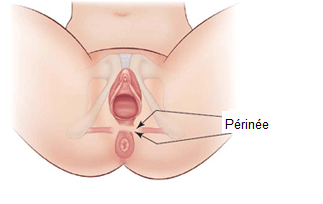Unless you have experienced trauma in this area before (picture below), the skin of the perineal area and the internal tissues is relatively flexible.
Obviously, the flexibility and elasticity of the perineal area varies from one individual to another, except that the female body is suited to giving birth and therefore, nature has indeed anticipated that a baby will pass through this region.
As you can see, the perineum is not a fragile part of the anatomy.
And yet, it is common for this region to be damaged during childbirth.
Open perineal tears are calculated by rank, on a scale of 1 to 4, depending on the area affected. In order, they affect the vaginal mucosa, the central fibrous nucleus of the perineum then the external anal sphincter and finally the internal sphincter and anal-rectal mucosa. When they occur, the physician or midwife will stitch them as soon as the placenta is comes out, after an assessment of the damage. Even if you have not had an epidural, the nurse/caregiver will anesthetize the area to be treated beforehand. Obviously, the deeper the tear, the longer it takes to repair. At this point, the process may be more sensitive, but not necessarily painful.
Physicians do not count the number of stitches made. If you want to know the severity of the injury, ask for the grade of the tear.
It is entirely possible to get through it without tearing, with a slight abrasion or bruising that requires few or no stitches.
An episiotomy, which consists of an incision with scissors, is no longer practiced straightaway as it would have been in the past. There must be a medical justification for performing this. It was previously believed that it prevents deeper tears, of a higher grade, but this is not the case. On the contrary. A natural tear respects the fibers of the tissues, unlike an episiotomy that weakens them further. The repair of a tear is more challenging for the physician or midwife since it never occurs in a nice straight line; however, the healing is much easier.
Speaking of healing…
 If you have only suffered bruising, the pain is more like a burn, more present when urinating. Take a small necked bottle, and fill it with warm water before going to the bathroom. When you urinate, simply run the water over the vulva at the same time. For larger tears, sitz baths are ideal. Feel free to use an inflatable ring to sit on, and do not remain in an uncomfortable or painful position. You may feed your baby lying on your side, or inclined in an armchair. It is not recommended to use soap on stitches.
If you have only suffered bruising, the pain is more like a burn, more present when urinating. Take a small necked bottle, and fill it with warm water before going to the bathroom. When you urinate, simply run the water over the vulva at the same time. For larger tears, sitz baths are ideal. Feel free to use an inflatable ring to sit on, and do not remain in an uncomfortable or painful position. You may feed your baby lying on your side, or inclined in an armchair. It is not recommended to use soap on stitches.
If it provides relief, it is suggested that you spray the stitches with cold water regularly throughout the day. Wear a cotton sanitary towel that is more breathable than conventional towels that contain plastic, and change it frequently.
The area is highly vascularized; it heals quickly. The stitches dissolve over 10 to 15 days and it is important to massage the wound to soften it as soon as possible. To do this, use a vegetable oil (sweet almond). Not surprisingly, grades 3 and 4 require more patience in terms of healing, and it is possible that pelvic floor exercises may be necessary.
At the Maternity there is a specialized service for the care of the perineum. You can request an appointment on 022 372 44 00.
